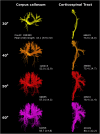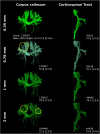Feasibility study to unveil the potential: considerations of constrained spherical deconvolution tractography with unsedated neonatal diffusion brain MRI data
- PMID: 39007078
- PMCID: PMC11239519
- DOI: 10.3389/fradi.2024.1416672
Feasibility study to unveil the potential: considerations of constrained spherical deconvolution tractography with unsedated neonatal diffusion brain MRI data
Abstract
Purpose: The study aimed to (1) assess the feasibility constrained spherical deconvolution (CSD) tractography to reconstruct crossing fiber bundles with unsedated neonatal diffusion MRI (dMRI), and (2) demonstrate the impact of spatial and angular resolution and processing settings on tractography and derived quantitative measures.
Methods: For the purpose of this study, the term-equivalent dMRIs (single-shell b800, and b2000, both 5 b0, and 45 gradient directions) of two moderate-late preterm infants (with and without motion artifacts) from a local cohort [Brain Imaging in Moderate-late Preterm infants (BIMP) study; Calgary, Canada] and one infant from the developing human connectome project with high-quality dMRI (using the b2600 shell, comprising 20 b0 and 128 gradient directions, from the multi-shell dataset) were selected. Diffusion tensor imaging (DTI) and CSD tractography were compared on b800 and b2000 dMRI. Varying image resolution modifications, (pre-)processing and tractography settings were tested to assess their impact on tractography. Each experiment involved visualizing local modeling and tractography for the corpus callosum and corticospinal tracts, and assessment of morphological and diffusion measures.
Results: Contrary to DTI, CSD enabled reconstruction of crossing fibers. Tractography was susceptible to image resolution, (pre-) processing and tractography settings. In addition to visual variations, settings were found to affect streamline count, length, and diffusion measures (fractional anisotropy and mean diffusivity). Diffusion measures exhibited variations of up to 23%.
Conclusion: Reconstruction of crossing fiber bundles using CSD tractography with unsedated neonatal dMRI data is feasible. Tractography settings affected streamline reconstruction, warranting careful documentation of methods for reproducibility and comparison of cohorts.
Keywords: constrained spherical deconvolution; diffusion MRI; diffusion tensor imaging; neonatal; tractography.
© 2024 Verschuur, Tax, Boomsma, Carlson, van Wezel-Meijler, King, Leemans and Leijser.
Conflict of interest statement
The authors declare that the research was conducted in the absence of any commercial or financial relationships that could be construed as a potential conflict of interest.
Figures










Similar articles
-
High angular resolution diffusion-weighted imaging and higher order tractography of the white matter tracts in the anterior thalamic area: Insights into deep brain stimulation targeting.Neuroimage Rep. 2024 Jun 14;4(3):100210. doi: 10.1016/j.ynirp.2024.100210. eCollection 2024 Sep. Neuroimage Rep. 2024. PMID: 40568572 Free PMC article.
-
Streamline tractography of the fetal brain in utero with machine learning.Imaging Neurosci (Camb). 2025 Apr 9;3:imag_a_00537. doi: 10.1162/imag_a_00537. eCollection 2025. Imaging Neurosci (Camb). 2025. PMID: 40800807 Free PMC article.
-
Structural connectome construction using constrained spherical deconvolution in multi-shell diffusion-weighted magnetic resonance imaging.Nat Protoc. 2025 Sep;20(9):2652-2684. doi: 10.1038/s41596-024-01129-1. Epub 2025 Feb 14. Nat Protoc. 2025. PMID: 39953164 Review.
-
Microstructural Characteristics of Cervical Spinal Cord Using High Angular Resolution Diffusion Imaging (HARDI) and Tractography in Healthy Subjects.Clin Neuroradiol. 2025 Jun;35(2):315-324. doi: 10.1007/s00062-024-01481-5. Epub 2024 Dec 20. Clin Neuroradiol. 2025. PMID: 39704830
-
Quantification of Diffusion Magnetic Resonance Imaging for Prognostic Prediction of Neonatal Hypoxic-Ischemic Encephalopathy.Dev Neurosci. 2024;46(1):55-68. doi: 10.1159/000530938. Epub 2023 May 10. Dev Neurosci. 2024. PMID: 37231858 Free PMC article. Review.
References
-
- Emsell L, Van Hecke W, Tournier J. Introduction to diffusion tensor imaging. In: Van Hecke W, editor. Diffusion Tensor Imaging. New York, NY: Springer; (2016). p. 7–19. 10.1007/978-1-4939-3118-7_2 - DOI
-
- Farquharson S, Tournier J. High angular resolution diffusion imaging. In: Van Hecke W, editor. Diffusion Tensor Imaging. New York, NY: Springer; (2016). p. 383–418. 10.1007/978-1-4939-3118-7_20 - DOI
Grants and funding
LinkOut - more resources
Full Text Sources

